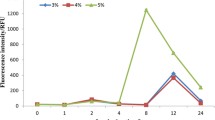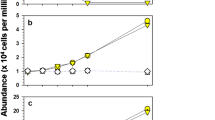Abstract
Algicidal bacteria have been turned out to be available for inhibiting Phaeocystis globosa which frequently caused harmful algal blooms and threatened to economic development and ecological balance. A marine bacterium Bacillus sp. Ts-12 exhibited significant algicidal activity against P. globosa by indirect attack. In present study, an algicidal compound was isolated by silica gel column, Sephadex G-15 column and HPLC, further identified as hexahydropyrrolo[1,2-a]pyrazine-1,4-dione, cyclo-(Pro-Gly), by GC-MS and 1H-NMR. Cyclo-(Pro-Gly) significantly increased the level of reactive oxygen species (ROS) within P. globosa cells, further activating the enzymatic and non-enzymatic antioxidant systems, including superoxide dismutase (SOD), catalase (CAT), glutathione (GSH) and ascorbic acid (AsA). The increase in methane dicarboxylic aldehyde (MDA) content showed that the surplus ROS induced lipid peroxidation on membrane system. Transmission electron microscope (TEM) and flow cytometry (FCM) analysis revealed that cyclo-(Pro-Gly) caused reduction of Chl-a content, destruction of cell membrane integrity, chloroplasts and nuclear structure. Real-time PCR assay showed that the transcriptions of photosynthesis related genes (psbA, psbD, rbcL) were significantly inhibited. This study indicated that cyclo-(Pro-Gly) from marine Bacillus sp. Ts-12 exerted photosynthetic inhibition and oxidative stress to P. globosa and eventually led to the algal cells lysis. This algicidal compound might be potential bio-agent for controlling P. globosa red tide.
Similar content being viewed by others
References
Ahmad, P., Jaleel, C.A., Salem, M.A., Nabi, G., and Sha rma, S. 2010. Roles of enzymatic and nonenzymatic antioxidants in plants during abiotic stress. Crit. Rev. Biotechnol. 30, 161–175.
Allahverdiyeva, Y., Mamedov, F., Maenpaa, P., Vass, I., and Aro, E.M. 2005. Modulation of photosynthetic electron transport in the absence of terminal electron acceptors: Characterization of the rbcl deletion mutant of tobacco. BBA-Bioenergetics 1709, 69–83.
Amaro, A.M., Fuentes, M.S., Ogalde, S.R., Venegas, J.A., and Suarez-Isla, B.A. 2005. Identification and characterization of potentially algal-lytic marine bacteria strongly associated with the toxic dinoflagellate Alexandrium catenella. J. Eukaryot. Microbiol. 52, 191–200.
Anderson, D.M., Cembella, A.D., and Hallegraeff, G.M. 2012. Progress in understanding harmful algal blooms: Paradigm shifts and new technologies for research, monitoring, and management, pp. 143–176. In C. A. Carlson and S. J. Giovannoni (eds.), Annual review of marine science, vol 4.
Apel, K. and Hirt, H. 2004. Reactive oxygen species: Metabolism, oxidative stress, and signal transduction. Annu. Rev. Plant Biol. 55, 373–399.
Asada, K. 2006. Production and scavenging of reactive oxygen species in chloroplasts and their functions. Plant Physiol. 141, 391–396.
Avery, S.V. 2011. Molecular targets of oxidative stress. Biochem. J. 434, 201–210.
Chagas, R.M., Silveira, J.A.G., Ribeiro, R.V., Vitorello, V.A., and Carrer, H. 2008. Photochemical damage and comparative performance of superoxide dismutase and ascorbate peroxidase in sugarcane leaves exposed to paraquat-induced oxidative stress. Pestic. Biochem. Physiol. 90, 181–188.
Chang, D.W., Hsieh, M.L., Chen, Y.M., Lin, T.F., and Chang, J.S. 2011. Kinetics of cell lysis for Microcystis aeruginosa and Nitzschia palea in the exposure to beta-cyclocitral. J. Hazard. Mater. 185, 1214–1220.
Duan, J.L., Li, X.J., Gao, J.M., Wang, D.S., Yan, Y., and Xue, Q.H. 2013. Isolation and identification of endophytic bacteria from root tissues of Salvia miltiorrhiza Bge. and determination of their bioactivities. Ann. Microbiol. 63, 1501–1512.
Erickson, J.M., Rahire, M., Malnoe, P., Girard-Bascou, J., Pierre, Y., Bennoun, P., and Rochaix, J.D. 1986. Lack of the D2 protein in a Chlamydomonas reinhardtii psbD mutant affects photosystem ii stability and d1 expression. EMBO J. 5, 1745–1754.
Foyer, C.H., Lelandais, M., and Kunert, K.J. 1994. Photooxidative stress in plants. Physiol. Plant. 92, 696–717.
Guan, C., Guo, X., Cai, G., Zhang, H., Li, Y., Zheng, W., and Zheng, T. 2014. Novel algicidal evidence of a bacterium Bacillus sp. Lp-10 killing Phaeocystis globosa, a harmful algal bloom causing species. Biol. Control 76, 79–86.
Ham, M.H., Choi, J.H., Boghossian, A.A., Jeng, E.S., Graff, R.A., Heller, D.A., Chang, A.C., Mattis, A., Bayburt, T.H., Grinkova, Y.V., et al. 2010. Photoelectrochemical complexes for solar energy conversion that chemically and autonomously regenerate. Nat. Chem. 2, 929–936.
Hamilton, C.E., Gundel, P.E., Helander, M., and Saikkonen, K. 2012. Endophytic mediation of reactive oxygen species and antioxidant activity in plants: A review. Fungal Divers. 54, 1–10.
Hong, Y., Hu, H.Y., Xie, X., Sakoda, A., Sagehashi, M., and Li, F.M. 2009. Gramine-induced growth inhibition, oxidative damage and antioxidant responses in freshwater cyanobacterium Microcystis aeruginosa. Aquat. Toxicol. 91, 262–269.
Jeong, S.Y., Ishida, K., Ito, Y., Okada, S., and Murakami, M. 2003. Bacillamide, a novel algicide from the marine bacterium, Bacillus sp. sy-1, against the harmful dinoflagellate, cochlodinium polykrikoides. Tetrahedron Lett. 44, 8005–8007.
Kim, M.J., Jeong, S.Y., and Lee, S.J. 2008. Isolation, identification, and algicidal activity of marine bacteria against Cochlodinium polykrikoides. J. Appl. Phycol. 20, 1069–1078.
Kim, Y.S., Son, H.J., and Jeong, S.Y. 2015. Isolation of an algicide from a marine bacterium and its effects against the toxic dinoflagellate Alexandrium catenella and other harmful algal bloom species. J. Microbiol. 53, 511–517.
Kobayashi, Y., Imamura, S., Hanaoka, M., and Tanaka, K. 2011. A tetrapyrrole-regulated ubiquitin ligase controls algal nuclear DNA replication. Nat. Cell Biol. 13, 483–487.
Kodani, S., Imoto, A., Mitsutani, A., and Murakami, M. 2002. Isolation and identification of the antialgal compound, harmane (1-methyl-β-carboline), produced by the algicidal bacterium, Pseudomonas sp. k44-1. J. Appl. Phycol. 14, 109–114.
Kwok, C.T., van de Merwe, J.P., Chiu, J.M.Y., and Wu, R.S.S. 2012. Antioxidant responses and lipid peroxidation in gills and hepatopancreas of the mussel Perna viridis upon exposure to the red-tide organism Chattonella marina and hydrogen peroxide. Harmful Algae 13, 40–46.
Larson, R.A. 1988. The antioxidants of higher plants. Phytochemistry 27, 969–978.
Lei, X., Li, D., Li, Y., Chen, Z., Chen, Y., Cai, G., Yang, X., Zheng, W., and Zheng, T. 2015. Comprehensive insights into the response of Alexandrium tamarense to algicidal component secreted by a marine bacterium. Front. Microbiol. 6.
Li, Z., Geng, M., and Yang, H. 2014a. Algicidal activity of Bacillus sp. Lzh-5 and its algicidal compounds against Microcystis aeruginosa. Appl. Microbiol. Biotechnol. 99, 981–990.
Li, Z., Lin, S., Liu, X., Tan, J., Pan, J., and Yang, H. 2014b. A freshwater bacterial strain, shewanella sp lzh-2, isolated from lake taihu and its two algicidal active substances, hexahydropyrrolo 1,2-a pyrazine-1,4-dione and 2, 3-indolinedione. Appl. Microbiol. Biotechnol. 98, 4737–4748.
Li, Y., Zhu, H., Guan, C., Zhang, H., Guo, J., Chen, Z., Cai, G., Lei, X., Zheng, W., Tian, Y., et al. 2014c. Towards molecular, physiological, and biochemical understanding of photosynthetic inhibition and oxidative stress in the toxic Alexandrium tamarense induced by a marine bacterium. Appl. Microbiol. Biotechnol. 98, 4637–4652.
Li, Y., Zhu, H., Lei, X., Zhang, H., Cai, G., Chen, Z., Fu, L., Xu, H., and Zheng, T. 2015. The death mechanism of the harmful algal bloom species alexandrium tamarense induced by algicidal bacterium deinococcus sp. Y35. Front. Microbiol. 6, 992.
Livak, K.J. and Schmittgen, T.D. 2001. Analysis of relative gene expression data using real-time quantitative pcr and the 2−ΔΔCT method. Methods 25, 402–408.
Luo, J., Wang, Y., Tang, S., Liang, J., Lin, W., and Luo, L. 2013. Isolation and identification of algicidal compound from streptomyces and algicidal mechanism to Microcystis aeruginosa. PLoS One 8, e76444.
Maughan, S.C., Pasternak, M., Cairns, N., Kiddle, G., Brach, T., Jarvis, R., Haas, F., Nieuwland, J., Lim, B., Mueller, C., et al. 2010. Plant homologs of the Plasmodium falciparum chloroquine-resistance transporter, PfCRT, are required for glutathione homeostasis and stress responses. Proc. Natl. Acad. Sci. USA. 107, 2331–2336.
Mihara, M. and Uchiyama, M. 1978. Determination of malonaldehyde precursor in tissues by thiobarbituric acid test. Anal. Biochem. 86, 271–278.
Pokrzywinski, K.L., Place, A.R., Warner, M.E., and Coyne, K.J. 2012. Investigation of the algicidal exudate produced by Shewanella sp. iri-160 and its effect on dinoflagellates. Harmful Algae 19, 23–29.
Qi, Y.Z., Chen, J.F., Wang, Z.H., Xu, N., Wang, Y., Shen, P.P., Lu, S.H., and Hodgkiss, I.J. 2004. Some observations on harmful algal bloom (hab) events along the coast of guangdong, southern china in 1998. Hydrobiologia 512, 209–214.
Qian, H., Sheng, G.D., Liu, W., Lu, Y., Liu, Z., and Fu, Z. 2008. Inhibitory effects of atrazine on Chlorella vulgaris as assessed by real-time polymerase chain reaction. Environ. Toxicol. Chem. 27, 182–187.
Qian, H., Xu, X., Chen, W., Jiang, H., Jin, Y., Liu, W., and Fu, Z. 2009. Allelochemical stress causes oxidative damage and inhibition of photosynthesis in Chlorella vulgaris. Chemosphere 75, 368–375.
Styring, S., Virgin, I., Ehrenberg, A., and Andersson, B. 1990. Strong light photoinhibition of electrontransport in photosystem ii. Impairment of the function of the first quinone acceptor, QA. Biochim. Biophys. Acta 1015, 269–278.
Tommonaro, G., Abbamondi, G.R., Iodice, C., Tait, K., and De Rosa, S. 2012. Diketopiperazines produced by the halophilic archaeon, Haloterrigena hispanica, activate AHL bioreporters. Microb. Ecol. 63, 490–495.
Yang, C.Y., Liu, S.J., Zhou, S.W., Wu, H.F., Yu, J.B., and Xia, C.H. 2011. Allelochemical ethyl 2-methyl acetoacetate (eMA) induces oxidative damage and antioxidant responses in Phaeodactylum tricornutum. Pestic. Biochem. Physiol. 100, 93–103.
Yang, X., Li, X., Zhou, Y., Zheng, W., Yu, C., and Zheng, T. 2014. Novel insights into the algicidal bacterium dh77-1 killing the toxic dinoflagellate Alexandrium tamarense. Sci. Total Environ. 482–483, 116–124.
Yang, C., Zhou, J., Liu, S., Fan, P., Wang, W., and Xia, C. 2013. Allelochemical induces growth and photosynthesis inhibition, oxidative damage in marine diatom Phaeodactylum tricomutum. J. Exp. Mar. Biol. Ecol. 444, 16–23.
Zhang, B., Cai, G., Wang, H., Li, D., Yang, X., An, X., Zheng, X., Tian, Y., Zheng, W., and Zheng, T. 2014a. Streptomyces alboflavus rps and its novel and high algicidal activity against harmful algal bloom species phaeocystis globosa. PLoS One 9.
Zhang, H., Lv, J., Peng, Y., Zhang, S., An, X., Xu, H., Zhang, J., Tian, Y., Zheng, W., and Zheng, T. 2014b. Cell death in a harmful algal bloom causing species Alexandrium tamarense upon an algicidal bacterium induction. Appl. Microbiol. Biotechnol. 98, 7949–7958.
Zhao, L., Chen, L., and Yin, P. 2014. Algicidal metabolites produced by Bacillus sp. strain b1 against Phaeocystis globosa. J. Ind. Microbiol. Biotechnol. 41, 593–599.
Zheng, X., Zhang, B., Zhang, J., Huang, L., Lin, J., Li, X., Zhou, Y., Wang, H., Yang, X., Su, J., et al. 2013. A marine algicidal actinomycete and its active substance against the harmful algal bloom species Phaeocystis globosa. Appl. Microbiol. Biotechnol. 97, 9207–9215.
Author information
Authors and Affiliations
Corresponding authors
Rights and permissions
About this article
Cite this article
Tan, S., Hu, X., Yin, P. et al. Photosynthetic inhibition and oxidative stress to the toxic Phaeocystis globosa caused by a diketopiperazine isolated from products of algicidal bacterium metabolism. J Microbiol. 54, 364–375 (2016). https://doi.org/10.1007/s12275-016-6012-0
Received:
Revised:
Accepted:
Published:
Issue Date:
DOI: https://doi.org/10.1007/s12275-016-6012-0




